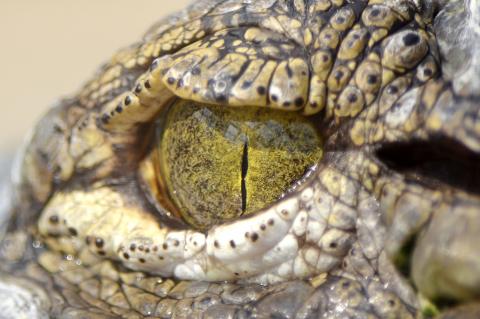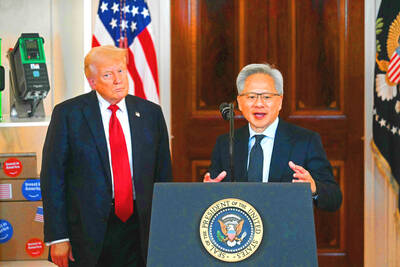Chinese practice
貓哭耗子
(mao1 ku1 hao4 zi5)

Photo: Wikimedia Commons
照片:維基共享資源
the cat weeps for the dead mouse
哥倫布顯然曾受到十四世紀《約翰‧曼德維爾爵士的旅行》一書的啟發而展開探險。在約翰‧阿什頓一八九○年出版的《動物學中奇妙的生物》一書中引用了曼德維爾對鱷魚(crocodile,曼德維爾拼作cockodrill)的描述,曼德維爾說:「這些毒獸殺害人,並在吃人的時候一邊流著淚,且牠們沒有舌頭。」
其實古時即有人認為鱷魚在吃獵物時一邊流淚,這種看法經由拉丁文的影響而見諸後世多種歐洲語言。
鱷魚確實有淚腺,並可產生淚水,但沒有任何跡象顯示他們是出於情感而哭泣,當然也不是因為不得不殺死像人類這種複雜生物以填飽肚子,而造成什麼內心的糾葛與自責。鱷魚「哭泣」的原因可能是由於長時間離開水中而需要濕潤眼睛,或如鹹水鱷魚需以眼淚來沖洗掉眼睛多餘的鹽分。
然而,幾世紀以來,「weeping crocodile tears」被用來指偽善者表達虛假的情感,或在敵人遭遇不幸時表示悲傷。
中文成語「貓哭耗子」,字面上的意思為「貓為死掉的老鼠哭泣」,這和鱷魚的眼淚有著完全相同的內涵:其所表達情感的真實性令人深深懷疑。「貓哭耗子」一語出自清‧史玉昆所著《小五義》,其成書年代要略早於上述《動物學中奇妙的生物》。
(台北時報編譯林俐凱譯)
別再那邊貓哭耗子了!你其實根本就是幸災樂禍。
(Sure, cry those crocodile tears. I know you love schadenfreude.)
這些政客明明投下了反對票,還說同情我們的立場,真是貓哭耗子假慈悲。
(These politicians voted against the bill, and still they say they have sympathy for our position. They’re just shedding crocodile tears.)
英文練習
to weep crocodile tears
Christopher Columbus was apparently inspired by the 14th century eponymously-named book The Travels of Sir John Mandeville. Mandeville is quoted in John Ashton’s 1890 book Curious Creatures in Zoology as describing the crocodile — or “cockodrill,” as Mandeville spelled it — thus: “These serpents sley men, and eate them weeping, and they have no tongue.”
This idea that crocodiles cry as they eat their prey is actually an ancient belief that found its way into many European languages by way of Latin.
It is true that crocodiles do have lacrimal glands and can produce tears, but there is no suggestion that they cry through emotion, and certainly not through some kind of conflicted remorse at having to slay such a complex creature as a human being to nourish their own bodies. The reason crocs “cry” is probably more to lubricate their eye following long periods out of the water or, in the case of saltwater crocodiles, to wash away excess salt.
Nevertheless, for centuries the concept of “weeping crocodile tears” has been used to refer to hypocrites showing insincere displays of emotion, or expressing grief when an enemy encounters misfortune.
In Chinese, there is the idiom 貓哭耗子, literally “the cat weeps for the dead mouse,” and this has exactly the same connotation: that there is a deep suspicion of the authenticity of the emotion expressed. It originally appears in the book Five Little Heroes by the Qing dynasty storyteller Shi Yukun, writing in the 19th century, just a little before Curious Creatures in Zoology was published.
(Paul Cooper, Taipei Times)
I can’t believe the hypocrisy of that man. He’s not really upset: those are crocodile tears he’s crying.
(那個人的虛偽真是不可置信。他才不是真的難過,那只不過是鱷魚的眼淚罷了。)
Oh, yeah, I know you can put on the waterworks, but I can tell crocodile tears when I see them.
(哎呀我知道你一哭起來就停不了,但若你是貓哭耗子假慈悲,我是一眼就可以看出來的。)

When Nvidia CEO Jensen Huang revealed on Friday last week that the company is working with the Trump administration on a new computer chip designed for sale to China, it marked the latest chapter in a long-running debate over how the US should compete with China’s technological ambitions. The reasoning has sometimes changed — with US officials citing national security, human rights or purely economic competition — but the tool has been the same: export controls, or the threat of them. Nvidia believes it can eventually reap US$50 billion from artificial intelligence (AI) chip sales in China. But it so far has

Long before numerals and arithmetic systems developed, humans relied on tally marks to count. These simple, repeated marks — often just straight lines — are one of the earliest and most widespread methods of recording numbers. Archaeological findings suggest that humans began tallying in prehistoric times. During the Late Stone Age in Africa, humans began to carve notches onto bones to create tangible records of quantities. One of the earliest known examples is the Wolf bone, an artifact unearthed in Central Europe in 1937. This bone bears notches believed to be an early form of counting. Even more intriguing

Continued from yesterday(延續自昨日) https://www.taipeitimes.com/News/lang In many Western countries, the most common form of tally marks employs a five-bar gate structure: four vertical lines followed by a diagonal slash. To form this group, one begins by drawing four parallel vertical lines, each representing one. For the fifth, draw a diagonal line across the existing four. This diagonal stroke effectively creates a distinct group of five. To continue counting, just initiate a new cycle in the same manner. A set of five tallies combined with a single vertical line next to it represents the number six. Across many Asian countries, the Chinese character

Week 23 : 詞法——名詞 1. 請給我兩張紙。 ˇ Please hand me two sheets of paper. χ Please hand me two papers. 註︰paper 作物質名詞(material noun)「紙」解時,沒有複數形式,要表達數量時前面要加量詞,作「學術報告」、「報紙」、「考卷」或「論文」等解時,可有複數形式。常見的物質名詞還有麵包(bread)、粉筆(chalk)等。 2. 祖母的頭髮已變灰白了。 ˇ Grandmother’s hair has already turned gray. χ Grandmother’s hairs have already turned gray. 註︰hair 統指頭髮(或毛)時只用單數。hairs 指多根頭髮(或毛),例如:She has several gray hairs.。另外,英文裡提到白頭髮習慣上多以 gray 一詞來代替 white,較為委婉含蓄。 3. 他沒有多少工作要做。 ˇ He doesn’t have a lot of work to do. χ He doesn’t have a lot of works to do. 註︰work 若指「工作」是不可數名詞,不能加 s,且不用不定冠詞。work 的複數形式表示下列幾種意義:(1) 著作,如 Chaucer’s works;(2) 工廠,如 China Steel Works;(3) 機器的轉動部分,如 the works of a watch;(4) 工程,如 public works。 4. 這是個好消息。 ˇ This is very good news. ˇ This is great news. χ This is such a good news. 註︰news 是不可數名詞,雖具有複數形式,但只用作單數,前面不可加 a,後面的動詞也應用第三人稱單數,如:Bad news travels quickly.